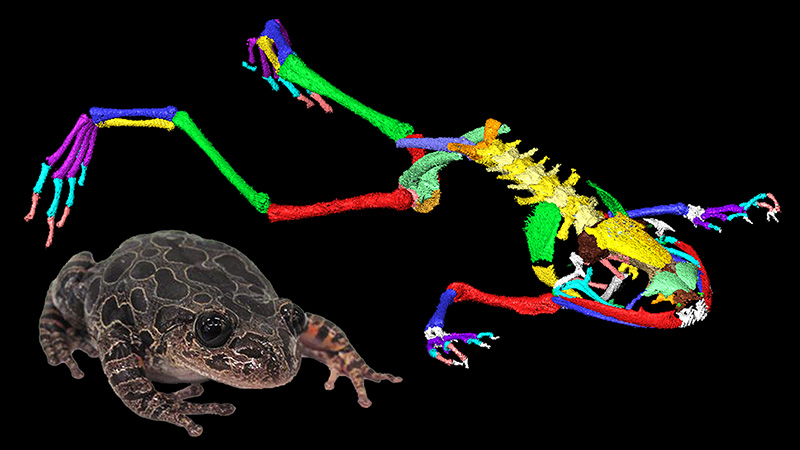New research reveals frogs’ impressive ability to jump at an extreme range of take-off angles
The frog skeleton is unique compared to those of other land-based vertebrates and appears to have evolved over hundreds of millions of years to be specially adapted for jumping.
Two new papers, published in the Journal of Experimental Biology, reveal how frogs are able to control their elongate hind legs with precision to achieve a wide range of jump angles, from nearly horizontal to almost vertical.
The papers were led by Dr. Christopher Richards and Dr. Laura Porro at the Royal Veterinary College (UK), and co-authored by PhD students Amber Collings (RVC) and Enrico Eberhard (RVC) with contributions by Kyle Chadwick (formerly of the RVC, now based at the University of Southern California).
The team collected experimental data using high-speed cameras (see video below) and ultra-sensitive force plates during jumping in Kassina maculata, the red-legged running frog. As its name suggests, this African species is capable not only of jumping but can also walk and run as well as climb and swim. This is the first study to collect such data from a “multi-functional” frog rather than a jumping specialist.
Experiments demonstrated that – despite the diverse ways Kassina can move about – its jumping performance was similar to that of frog species considered to be specialized jumpers. However, the real surprise was the extreme range of jump angles the frogs achieved.
Dr. Porro said: “Some jumps were nearly horizontal, with animals skimming over the ground; in other trials, the frogs rocketed upwards almost vertically. Their capacity to jump at such a wide range of angles and distances is amazing.”
The team used sophisticated computer modelling techniques to understand how frogs controlled and powered these jumps. The 3D motions of a frog leg are astonishingly complex. To understand the movements, the team borrowed techniques from robotics analysis which allowed them to compute how such intricate motions of the leg joints added up to push the body forward and upward.

A second modelling method – inverse dynamics analysis – allowed the team to understand how much each individual leg joint contributed to jumping. They found that forward power (thrust) comes primarily from the hip joint while most of the vertical movement (lift) is driven by the ankle. But it is a third joint – the knee – that appears to be crucial in positioning the leg and determining the final take-off angle.
“The ability to jump at a wide range of angles is probably very important to this species as they hunt insects in trees at night and need to be able to move around in a complex, 3D environment,” said Porro. This interdisciplinary study combined classic experimental methods with cutting-edge biomechanical modelling techniques to reveal new insight into how major changes in anatomy are linked to the evolution of extraordinary behaviours in living animals.
Future work will use these modelling methods to understand jumping in frog species specialised for swimming and burrowing, as well as in the earliest fossil frogs.
Research References
This study was funded by a European Research Council starting grant to Dr. Christopher Richards and published in the academic Journal of Experimental Biology on the 17th of May 2017:
- Inverse dynamic modelling of jumping in the red-legged running frog Kassina maculata
- Kinematic control of extreme jump angles in the red leg running frog Kassina maculata
Press Office Contact
Uche Graves / Zoe Chadwick
T: 0800 368 9520
E: uche.graves@plmr.co.uk / zoe.chadwick@plmr.co.uk
Notes to Editors
The Royal Veterinary College (RVC) is the UK's largest and longest established independent veterinary school and is a constituent College of the University of London. The RVC offers undergraduate, postgraduate and CPD programmes in veterinary medicine, veterinary nursing and biological sciences, being ranked in the top 10 universities nationally for biosciences degrees. It is currently the only veterinary school in the world to hold full accreditation from AVMA, EAEVE, RCVS and AVBC.
A research-led institution, in the most recent Research Excellence Framework (REF2014) the RVC maintained its position as the top HEFCE funded veterinary focused research institution.
The RVC also provides animal owners and the veterinary profession with access to expert veterinary care and advice through its teaching hospitals; the Beaumont Sainsbury Animal Hospital in central London, the Queen Mother Hospital for Animals (Europe's largest small animal referral centre), the Equine Referral Hospital, and the Farm Animal Clinical Centre located at the Hertfordshire campus.
RVC Press Release 18 May 2017
See other Press Releases.
